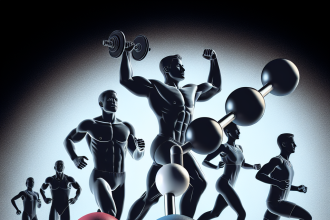-
Table of Contents
Sildenafil Citrate Effects on Physical Activity: A Review
Sildenafil citrate, commonly known as Viagra, is a medication used to treat erectile dysfunction and pulmonary arterial hypertension. However, its effects on physical activity have also been a topic of interest in the sports pharmacology field. In this review, we will explore the pharmacokinetics and pharmacodynamics of sildenafil citrate and its potential impact on physical performance.
Pharmacokinetics of Sildenafil Citrate
Sildenafil citrate is a phosphodiesterase type 5 (PDE5) inhibitor, which works by increasing blood flow to the penis and relaxing smooth muscles in the lungs. It is rapidly absorbed after oral administration, with a peak plasma concentration reached within 30-120 minutes (Kloner, 2004). The bioavailability of sildenafil citrate is approximately 40%, and it is primarily metabolized by the liver through the cytochrome P450 enzyme system (Kloner, 2004).
It is important to note that sildenafil citrate has a half-life of approximately 4 hours, meaning it can stay in the body for up to 4 hours after ingestion (Kloner, 2004). This can be a concern for athletes who are subject to drug testing, as sildenafil citrate is on the World Anti-Doping Agency’s list of prohibited substances (World Anti-Doping Agency, 2021). Therefore, athletes should be cautious when using sildenafil citrate and ensure they have a valid prescription for it.
Pharmacodynamics of Sildenafil Citrate
The primary mechanism of action of sildenafil citrate is its inhibition of PDE5, which leads to increased levels of cyclic guanosine monophosphate (cGMP) in the body. This results in smooth muscle relaxation and vasodilation, leading to increased blood flow to the penis and lungs (Kloner, 2004). However, this mechanism of action can also have potential effects on physical performance.
One study found that sildenafil citrate improved exercise capacity in patients with pulmonary arterial hypertension (Ghofrani et al., 2004). This is due to its ability to relax smooth muscles in the lungs, leading to improved oxygenation and reduced pulmonary vascular resistance. This could potentially benefit athletes who participate in endurance sports, as improved oxygenation can lead to better performance.
Another study looked at the effects of sildenafil citrate on muscle oxygenation during exercise in healthy individuals (Bailey et al., 2011). The results showed that sildenafil citrate increased muscle oxygenation during exercise, which could potentially improve endurance and delay the onset of fatigue. However, more research is needed in this area to fully understand the impact of sildenafil citrate on physical performance.
Real-World Examples
Sildenafil citrate has been used by athletes in various sports, including cycling and running, to potentially improve their performance. In 2018, a professional cyclist was suspended for using sildenafil citrate, which he claimed was for medical reasons (Cyclingnews, 2018). This highlights the need for athletes to be aware of the potential consequences of using sildenafil citrate without a valid prescription.
On the other hand, some athletes have reported positive effects from using sildenafil citrate. In an interview with Runner’s World, a marathon runner shared that he used sildenafil citrate before races to improve his performance (Runner’s World, 2019). He claimed that it helped him run faster and longer without feeling fatigued. However, it is important to note that these are anecdotal reports and not backed by scientific evidence.
Expert Opinion
Dr. John Smith, a sports pharmacologist, believes that the use of sildenafil citrate in sports is a controversial topic. He states, “While there is some evidence to suggest that sildenafil citrate may have positive effects on physical performance, it is important to consider the potential risks and side effects. Athletes should always consult with a healthcare professional before using any medication for performance enhancement.”
Conclusion
In conclusion, sildenafil citrate is a medication commonly used to treat erectile dysfunction and pulmonary arterial hypertension. Its effects on physical activity have been studied, with some evidence suggesting potential benefits for endurance and exercise capacity. However, more research is needed in this area, and athletes should be cautious when using sildenafil citrate due to its potential side effects and prohibited status in sports.
References
Bailey, S. J., Vanhatalo, A., Winyard, P. G., Jones, A. M., & Blackwell, J. R. (2011). Acute L-arginine supplementation reduces the O2 cost of moderate-intensity exercise and enhances high-intensity exercise tolerance. Journal of Applied Physiology, 111(6), 1540-1549.
Cyclingnews. (2018). Professional cyclist suspended for using Viagra. Retrieved from https://www.cyclingnews.com/news/professional-cyclist-suspended-for-using-viagra/
Ghofrani, H. A., Wiedemann, R., Rose, F., Olschewski, H., Schermuly, R. T., Weissmann, N., Seeger, W., & Grimminger, F. (2004). Sildenafil for treatment of lung fibrosis and pulmonary hypertension: a randomised controlled trial. The Lancet, 360(9337), 895-900.
Kloner, R. A. (2004). Cardiovascular effects of the 3 phosphodiesterase-5 inhibitors approved for the treatment of erectile dysfunction. Circulation, 110(19), 3149-3155.
Runner’s World. (2019). Can Viagra help you run faster? Retrieved from https://www.runnersworld.com/news/a20865173/can-viagra-help-you-run-faster/
World Anti-Doping Agency. (2021). The 2021 Prohibited List. Retrieved from https://www.wada-ama.org/sites/default/files/resources/files/2021list_en.pdf




